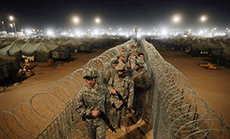
Report: US Fired Depleted Uranium in Civilian Areas During 2003 Iraq Invasion

Local Editor
A new Dutch NGO study revealed that US-led forces in Iraq used depleted uranium weapons in civilian-populated areas during the 2003 military invasion, also exposing a lack of adequate cleanup efforts by the invading troops.
 The majority of the DU rounds fired by the US-led coalition were in heavily populated areas, the group said. Samawah, Nasiriyah and Basrah are just some urban areas where ammunition was deployed.
The majority of the DU rounds fired by the US-led coalition were in heavily populated areas, the group said. Samawah, Nasiriyah and Basrah are just some urban areas where ammunition was deployed.
Most of the firing locations remain unknown, as more than 300,000 DU rounds are believed to have been fired by US-led coalition.
The author of the report, Wim Zwijnenburg, said the US Air Force knew of the consequences of using DU ammunition.
"The use of DU against these targets questions the adherence of coalition forces to their own principles and guidelines. They should be held accountable for the consequences," Zwijnenburg said, citing a 1975 memo from the Air Force Office of the Judge Advocate that restricted the use of such ammunition.
"Use of this munition solely against personnel is prohibited if alternative weapons are available," the memo said, because of "unnecessary suffering and poison."
Moreover, "Coalition forces were aware of the potential health and environmental impact of DU munitions, yet refrained from undertaking the necessary clean-up of DU outside their own bases," a summary of the report read.
The GPS coordinates of DU rounds were initially handed
over to the Dutch Defense Ministry because the Netherlands was worried
about the potential contamination of its own troops in the country. The
ministry later shared the information with PAX under a freedom of
information law.
According to an earlier PAX report, more than 300 sites in Iraq are currently contaminated with depleted uranium and it would cost at least $30 million to clean up.
Inside the body, DU's hazards are its chemical toxicity and radioactivity. DU primarily emits alpha radiation. Alpha radiation can disrupt cellular process and damage DNA, which can lead to an increased risk of developing different types of cancer, depending on which organ is exposed. DU is also a heavy metal and therefore chemically toxic.
Source: News Agencies, Edited by website team
Comments
- Related News



